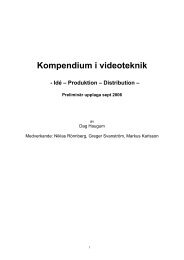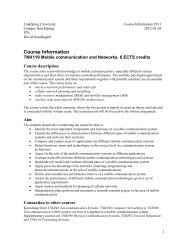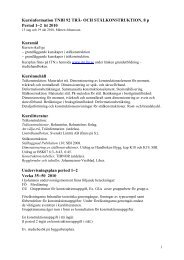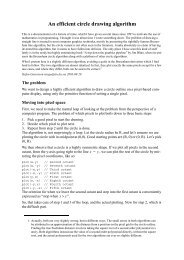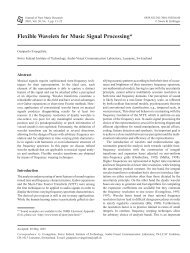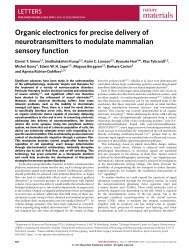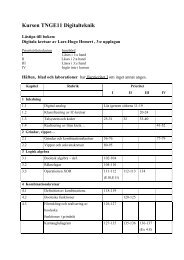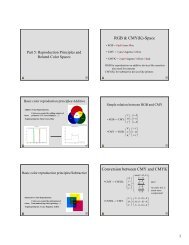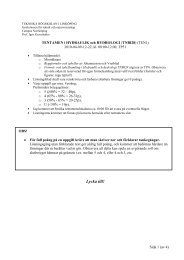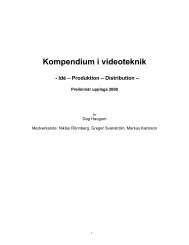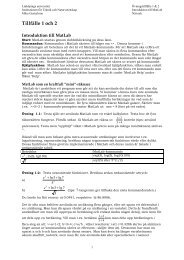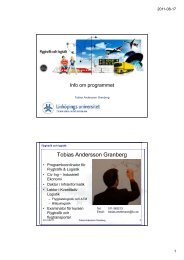Kommunikation och användargränssnitt - TNM006
Kommunikation och användargränssnitt - TNM006
Kommunikation och användargränssnitt - TNM006
You also want an ePaper? Increase the reach of your titles
YUMPU automatically turns print PDFs into web optimized ePapers that Google loves.
Ivan Rankin<br />
Communication and User<br />
Interfaces - TNM040<br />
• Course content<br />
– cognitive psychology<br />
• how humans interpret their environment<br />
• how humans process information<br />
• communication between humans<br />
– Human-computer interaction<br />
• interface design<br />
• methods for developing and evaluating useradapted<br />
computer systems<br />
1
Ivan Rankin<br />
Personnel<br />
Communication and User<br />
Interfaces - Formalities<br />
• Ivan Rankin, lectures, exam, labs<br />
Henry Fröcklin, labs, exam<br />
Josefin Quach, admin<br />
(email, addresses, etc. on home pages)<br />
2
Ivan Rankin<br />
Examination - contents<br />
• Computer labs in Java + test<br />
(individual)<br />
• Cognitive critique of user interfaces<br />
(oral examination, individual)<br />
• User interface design (group)<br />
• Home assignment (individual)<br />
3
Ivan Rankin<br />
TNM040 Examination<br />
week 35 36 37 38 39 40 41 42<br />
lectures<br />
Java<br />
GUI design in theory and practice<br />
critique<br />
home assignment<br />
4
Ivan Rankin<br />
TNM040 Examination<br />
• Points in total: 6<br />
• Programming: labs + GUI project 3p<br />
• Critique + home assignment 3p<br />
5
Ivan Rankin<br />
6
Ivan Rankin<br />
Four questions<br />
• Is troggel a Swedish word?<br />
No<br />
• How many of each animal species did<br />
Moses take on the ark?<br />
It was Noah on the ark<br />
• Did Galileo have fingers missing on one<br />
hand? No<br />
• What is the capital of the Lebanon?<br />
Bahrain Bagdad Beirut Barcelona?<br />
Beirut<br />
7
Ivan Rankin<br />
One more question<br />
5. How many ’v’s are there in the text below?<br />
vid viktiga förhandlingar är betydelsen av dokumentation<br />
av ingående beslut ett levande exempel på<br />
resultatet av flera års utbildning.<br />
8
Ivan Rankin<br />
Human-computer interaction<br />
(HCI)<br />
• In the beginning (1940s-1950s) only<br />
specialists used computers<br />
• 1970s the first personal computers arrived<br />
• 1970s-1980s the concept of ’user interface’<br />
meaning the parts of a computer program the<br />
user comes in contact with was introduced<br />
– Own code separate from the rest of the program<br />
9
Ivan Rankin<br />
Human-computer interaction<br />
• In the mid-1980s the term ’user-friendly’ was<br />
used:<br />
research on human capabilities and limitations<br />
when working with computers, eg.<br />
– cognitive (mental) processeses when using a computer,<br />
eg. what knowledge is required for a given purpose<br />
– work method<br />
– organisation<br />
– health issues<br />
10
Ivan Rankin<br />
Human-computer interaction<br />
• Work method<br />
– varied or routine assignments<br />
– speed<br />
• Organisation<br />
– who does what?<br />
– how is the organisation’s structure affected?<br />
• Health issues<br />
– sensitivity to electricity, repeated movements<br />
– ergonomics: design that takes human<br />
psychological and physical abilities into<br />
consideration<br />
11
Ivan Rankin<br />
Human-computer interaction<br />
• 1980s-1990s<br />
Human-computer interaction becomes an<br />
area of research:<br />
– what processes, actions does a human use in<br />
interacting with a computer? What does the<br />
dialogue/communcationen look like?<br />
�<br />
– design, implementation of interactive computer<br />
systems for human use<br />
• 1990s - usability<br />
– systems that make it easier for a human to<br />
perform a task<br />
12
Ivan Rankin<br />
Human-computer interaction<br />
• Increased interest for the human role in the<br />
interaction -<br />
but not as fast as technical advances<br />
• telephone – a simple example<br />
• video player<br />
• car<br />
13
Ivan Rankin<br />
HCI<br />
14
Ivan Rankin<br />
When HCI doesn’t work<br />
• In 1979 Meltdown at Three Mile Island Nuclear Plant<br />
• ” a valve opened but no-one noticed due to a series of technical<br />
and human errors”<br />
• In 1990 Indian Airlines airbus crashes<br />
• 320 died<br />
• ”the pilot didn’t adapt to the system”<br />
• In 1992 USAs Vincennes shoots down an Iranian passenger<br />
plane 290 dog<br />
• ”the computer system showed the correct information, but the<br />
operaters became victims of a trivial design error”<br />
15
Ivan Rankin<br />
When HCI works<br />
• Results after DEC’s development team<br />
put much effort into usability of a<br />
product (that generated various types of<br />
computer programa):<br />
– Sales increased by 80%<br />
– Customers found that increased usability<br />
was the second best feature of the new<br />
release (after functionality)<br />
16
Ivan Rankin<br />
Human-computer interaction<br />
• Three main aims of HCI<br />
– usability<br />
• easy to learn<br />
• easy to use (more om usability later in course)<br />
– safety<br />
• A user must not be able to take actionss that have<br />
catastrophic consequences<br />
– functionality<br />
• computer programs that are suitable for the task<br />
17
Ivan Rankin<br />
Human-computer interaction<br />
• To achieve these goals:<br />
1. Understand factors on how humans use<br />
computers:<br />
• human mental abilities, limitations, wishes<br />
• ergonomics – take into consideration human physical and<br />
psychological abilities<br />
• understanding the environment around the human<br />
– Organisational factors<br />
– Social issues<br />
2. Develop tools and techniques adapted to the user<br />
18
Ivan Rankin<br />
Communication and user<br />
interfaces<br />
”Morgondagens civilingenjör är en<br />
kommunicerande <strong>och</strong> socialt kompetent<br />
person, med kunskaper <strong>och</strong> färdigheter<br />
inom en mängd olika kompletterande<br />
områden.”<br />
CivilingenjörsFörbundet<br />
19
Ivan Rankin<br />
Communication and user<br />
What is required:<br />
interfaces<br />
”...kunskaper <strong>och</strong> färdigheter i att<br />
handha produkter, processer <strong>och</strong><br />
arbetsmiljö med hänsyn till människors<br />
förutsättningar <strong>och</strong> behov.”<br />
Högskoleförordningen<br />
20
Ivan Rankin<br />
Psychology<br />
• Greek psyke = mind, soul, consciousness,<br />
intellect<br />
logos = science, knowledge<br />
• Definition:<br />
Psychology is the science of human behaviour<br />
and mental processes<br />
21
Ivan Rankin<br />
learning<br />
thought<br />
processes<br />
mental training,<br />
eg. sport<br />
Areas in psychology<br />
mental load<br />
knowledge<br />
behaviour<br />
deviational<br />
behaviour<br />
perception<br />
attention<br />
memory<br />
22
Ivan Rankin<br />
Psychology - milestones<br />
• Psychology was viewed as a part of philosophy in<br />
the early days<br />
• Psychology becomes a science in its own right<br />
– 1879: Wundt established a laboratory for psychological<br />
research at Leipzig University<br />
• Introduced scientific methods into psychological research<br />
– Experiments: measuring perceptual processes (vision, hearing<br />
– Introspection (self observation)<br />
23
Ivan Rankin<br />
Psychology – Wundt’s laboratory<br />
It all<br />
started in<br />
Leipzig<br />
in 1879<br />
24
• 1880s<br />
Ivan Rankin<br />
Psychology - milestones<br />
– Laboratories in the USA (eg. William James, Harvard<br />
University)<br />
• How does consciousness work so that humans can adapt to<br />
their environment? (ie. how do we learns?)<br />
This basic question developed later into behaviourism<br />
• What mental processes are there?<br />
– Ebbinghaus and memory experiments (1885)<br />
• Forgetfulness curve<br />
25
Ivan Rankin<br />
Ebbinghaus’ curve<br />
We forget<br />
quickly in the<br />
beginning<br />
NB. This applies to<br />
learning lists of<br />
nonsense syllables<br />
Slower<br />
later on<br />
26
Ivan Rankin<br />
Psychology - milestones<br />
• Three main schools within psychology<br />
become established in the 20th century:<br />
– Behaviourism<br />
– Gestalt-theory<br />
– Psychoanalysis<br />
27
Ivan Rankin<br />
Behaviourism<br />
• Behaviourism (Watson, Skinner, Pavlov)<br />
– Basic notions:<br />
• Our consciousness is private, not open to analysis<br />
• What we can observe is behaviour<br />
animals / humnas (facts)<br />
• Stimuli (S) produce responses (R) (behaviour)<br />
S � R<br />
– Our behaviour is formed by stimuli around us<br />
– Positive reinforcement encourages us to continue with the<br />
same behaviour; negative reinforcement means we avoid<br />
certain behaviours<br />
• Reinforcement leads to conditioned reflexes<br />
(a type of behaviour)<br />
28
Ivan Rankin<br />
Psychology - milestones<br />
• 1910-50 Behaviourism is the main field of<br />
psychology for the next 40 years<br />
– Pavlov (Russia): experimented with dogs’ digestive<br />
systems<br />
• a certain behavior can be achieved in animals<br />
– Skinner (USA): best known for explaining how animals<br />
learn (adapt their behaviour to stimuli)<br />
• eg. rats in a maze<br />
– Humans can be formed<br />
• how do people behave in a group?<br />
• what leads to improved performance?<br />
29
Ivan Rankin<br />
Behaviourism - Pavlov<br />
30
Ivan Rankin<br />
Behaviourism - Skinner<br />
The mouse<br />
has learned<br />
an optimal<br />
path through<br />
the maze<br />
31
Ivan Rankin<br />
Behaviourism - Skinner<br />
32
The pidgeons<br />
have learned<br />
to peck when<br />
they see<br />
something<br />
orange<br />
Ivan Rankin<br />
Behaviourism<br />
33
Average<br />
number of<br />
errors<br />
Ivan Rankin<br />
Behaviourism - Skinner<br />
generations<br />
Less talented<br />
mice are paired<br />
with each other<br />
from generation<br />
to generation –<br />
they become<br />
even less<br />
talented<br />
Smart<br />
mice get<br />
smarter<br />
34
Ivan Rankin<br />
Behaviourism in 1960<br />
35
Ivan Rankin<br />
Psychology – the first women<br />
– In 1905 Mary Whiton Calkins was the first female<br />
president, American Psychological Association<br />
Harvard University (James) refuses to let her do a<br />
Ph.D. because she is female<br />
– Margaret Washburn is also refused a doctorate at<br />
Columbia University for the same reason.<br />
She moved to Cornell University and in 1921<br />
became the first female doctor in psychology<br />
36
Ivan Rankin<br />
Mary Whiton Calkins<br />
37
Ivan Rankin<br />
Watson, Crick, Wilkins, Franklin 62<br />
38
Ivan Rankin<br />
Gestalt theory<br />
• 1912 Gestalt theory in Germany<br />
– Gestalt = form, shape, configuration<br />
– Basic notions:<br />
• To understand out environment we must be able to<br />
see whole figures in it and the relationships among<br />
them<br />
eg. To distinguish objects from each other and<br />
from the background<br />
• Our perceptual processes are based on patterns that<br />
– partly come from stimuli (in the environment<br />
– are partly organized on the basis of previous<br />
experience<br />
• There are basic principles behind the organization of<br />
perceptual stimuli<br />
– Aim: to determine these principles<br />
39
We<br />
experience<br />
a whole<br />
figure<br />
Ivan Rankin<br />
We experience more<br />
than we see<br />
Gestalt figures<br />
Continuity principle<br />
Two crossing<br />
lines – not two<br />
V-shaped figures<br />
40
Ivan Rankin<br />
Gestalt figures – how we<br />
columns or<br />
rows?<br />
organize reality<br />
columns<br />
according to the<br />
proximity<br />
principle<br />
41
Ivan Rankin<br />
Gestalt figures – how we<br />
O O O O O<br />
X X X X X<br />
S S S S S<br />
T T T T T<br />
Rows according<br />
to the similarity<br />
principle<br />
organize reality<br />
Gestalt-teori Behaviorism Psykoanalys<br />
Gestalt-teori Behaviorism Psykoanalys<br />
Gestalt-teori Behaviorism Psykoanalys<br />
Gestalt-teori Behaviorism Psykoanalys<br />
Gestalt-teori Behaviorism Psykoanalys<br />
Gestalt-teori Behaviorism Psykoanalys<br />
Columns (or rows?)<br />
according to the<br />
similarity principle<br />
42
Ivan Rankin<br />
STOP WAR<br />
PEACE NOW<br />
Gestalt figures<br />
STOP<br />
Colour and shading<br />
also contribute to how<br />
we see ’wholes’<br />
PEACE<br />
WAR<br />
NOW<br />
43
Ivan Rankin<br />
Gestalt theory<br />
What is object,<br />
what is<br />
bakground?<br />
44
Ivan Rankin<br />
Psychology - milstones<br />
• 1910-talet - Psychoanalysis (Freud)<br />
• Basic idea: the conscious is just a part of our mental<br />
processes<br />
– ’Neuroses’ are caused be memories of previous<br />
events that have been suppressed, but which are still<br />
in our subconscious.<br />
– Forbidden desires from our childhood remain in our<br />
subconscious<br />
– These force their way forward and lead to abnormal<br />
behaviour<br />
Solution: Confront the patient with these memories<br />
45
Ivan Rankin<br />
Freud and daughter<br />
46
Ivan Rankin<br />
Psychology - milstones<br />
• The cognitive revolution 1940-1960<br />
– Information theory (machines)<br />
• input-reaction-feedback loop<br />
– Linguistics<br />
• Language can not be described in behaviouristic terms<br />
• Requires complex psychological mechanisms<br />
– Computer science/ computer hardware<br />
• Computers and software become avaialabe for non-experts<br />
• A computer system accepts input, processes data, has a memory,<br />
can react in different ways in different contexts<br />
– Neurology<br />
• Major progress made on the structure and functioning of the brain<br />
47
Ivan Rankin<br />
Psychology - milstones<br />
• 1930s–1940s Information theory<br />
develops (Shannon, USA)<br />
– What is information?<br />
– Communication of information via<br />
electromechanical relays<br />
– Definition: One bit of information halves the<br />
uncertainty of possible outcomes<br />
– Information is described on an abstract level (the<br />
model is independent of any mechanism – human<br />
or machine)<br />
48
Ivan Rankin<br />
Shannon (1942) on information<br />
X<br />
njnjnn - 6 bits of information are required to lokalize the cross<br />
(6 bits in another notation 010100)<br />
49
Ivan Rankin<br />
Information theory<br />
• Psychologists compare humans and<br />
machines as information processors<br />
– Both accepts signals from the environment and<br />
react accordingly (eg. a thermostat)<br />
– Both have limited capacity (eg. telephone cables<br />
or the ability to listen to several conversations<br />
simultaneously)<br />
– The human as ’information processor with limited<br />
capacity’<br />
50
Ivan Rankin<br />
Psychology - milstones<br />
• Linguistics<br />
– Previously it was thought that a child<br />
learned a language by imitating its mother<br />
– This cannot explain how a child can<br />
produce its own words and structures<br />
– This cannot explain how we can be<br />
linguistically creative<br />
– The need for more than behaviourism<br />
grows<br />
51
Ivan Rankin<br />
Psychology - milstones<br />
• Computer science<br />
– Computers become available to non-experts<br />
– Computers are like people<br />
• A computer has a permanent memory<br />
• A computer has a working memory (RAM) = human<br />
short-term memory<br />
• A computer has a CPU (the human has a central<br />
processor - a mind)<br />
• A computer receives data and processes it - a human tar<br />
receives stimuli and precesses them<br />
52
Ivan Rankin<br />
Computer science<br />
• Turing (1950) proves that all types of<br />
calculations can be performed by a machine<br />
with simple properties<br />
• Computers perform symbol manipulation<br />
– eg. a program that calculates wages<br />
• Computers (programs) break down complex<br />
behaviours to a sequence of yes/no decisions<br />
53
Computer science<br />
• Manipulating symbols<br />
– What is 4 + 5?<br />
– The answer is automatic - now<br />
• Tables:<br />
1 + 1 = 2<br />
1 + 2 = 3<br />
…<br />
4 + 5 = 9 (compare programs for noughts and crosses)<br />
• Given: 1 2 3 4 5 6 7 8 9 10<br />
Look up 4. Move 5 steps to the right (the way children learn)<br />
• Human behaviour can be imitated in a computer<br />
Ivan Rankin<br />
54
Ivan Rankin<br />
Computer science<br />
– Human behaviour can be simulated in a computer<br />
program<br />
– To do this we need to know more about how<br />
humans function<br />
• Cognitive psychology needs both disciplines<br />
– In 1956 Herb Simon says to his students: ” during<br />
the Christmas break Allen Newell and I created a<br />
thinking machine”<br />
• It could do mathematical proofs, a field that had belonged<br />
only to humans before<br />
– Thinking machines have arrived<br />
55
Ivan Rankin<br />
Psychology - milstones<br />
• World War Two shows the need for more<br />
knowledge of (what will become) cognitive<br />
psychology<br />
– Understanding night vision (visual perception)<br />
– Understanding coded messages (problem solving)<br />
– Designing alert signals (auditive perception)<br />
– Capacity limitations of pilots<br />
• pilots only used a fraction of available information for most<br />
taks<br />
56
Ivan Rankin<br />
Surplus of information<br />
57
Ivan Rankin<br />
Neurology<br />
– New machines that can measure activity in<br />
the brain<br />
– Many brain injuries during the war (1939-45)<br />
• Localizing functions in the brain, eg.<br />
– Speech<br />
» Aphasia (reduced language ability)<br />
– Agnosia (reduced ability to recognize)<br />
– Vision and hearing functions<br />
58
Ivan Rankin<br />
Neurology<br />
Phineas Gage<br />
injured in 1848<br />
Caused<br />
personality<br />
changes<br />
59
Ivan Rankin<br />
Psychology - milstones<br />
• 1940s-1950s Behavioral Science Research<br />
in USA (Miller) and Human Factors<br />
Research in Britain (Broadbent)<br />
– Capacity limitations in out ability to process information<br />
– What information do we attend to? (selective attention)<br />
– We look for and react to feedback from the environment<br />
60
Ivan Rankin<br />
Psychology - milstones<br />
• From 1950-1960 growing interest for models<br />
used in computer science<br />
– Flowcharts<br />
– Working memory (short-term memory)<br />
– Information processing – not just calculations<br />
• Pattern recognition<br />
• Planning<br />
• Problem solving<br />
– Testing hypotheses objectively (models of<br />
informations processing)<br />
61
Ivan Rankin<br />
Broadbent’s flowchart (1958)<br />
62
Ivan Rankin<br />
The cognitive revolution<br />
Linguistics Computer<br />
science<br />
Artificial<br />
intelligence<br />
Cognitive<br />
psychology<br />
Neuroscience<br />
63
Ivan Rankin<br />
Examples of different fields in<br />
psychology today<br />
– Social psychology: how groups function<br />
– Development psychology : from birth to adulthood<br />
– Clinical psychology : patients with various problems,<br />
crisis management<br />
– Environmental psychology : we and out environment<br />
– Work psychology : work, workplace, organization<br />
– Parapsychology : the ’supernatural’<br />
64
Ivan Rankin<br />
Cognition<br />
• The term cognition refers to the processes<br />
by which we acquire knowledge:<br />
– How do we receive information from the<br />
environment<br />
– How does the brain process and store information<br />
– How do we reason and solve problems<br />
– How can we understand and use language<br />
65
Ivan Rankin<br />
Cognitive psychology<br />
• Lat. gnoscere = to know<br />
cognoscere = to get to know<br />
• Definition:<br />
Cognitive psychology is that part of<br />
pschology that deals with information<br />
processes, ie. our way of<br />
– acquiring, processing, storing and using<br />
information<br />
66
Ivan Rankin<br />
Cognitive psychology and HCI<br />
• Better knowledge of cognition can help us to<br />
produce better interfaces:<br />
– What can we expect from users?<br />
– How can we make the users’ task as simple as<br />
possible?<br />
– Identify and explain problems the user has or will<br />
have<br />
– Provide methods for creating interfaces that<br />
improve the users’ capacity<br />
67
Ivan Rankin<br />
Cognitive psychology<br />
• Based on the idea that mental processes can<br />
be divided into smaller steps<br />
• Each step accepts information from previous<br />
stages, treats it and passes information on to<br />
the next step<br />
Data (stimuli) are received by our sensory organs<br />
they are interpreted (with help of information in<br />
memory)<br />
a response is selected<br />
the response is performed (eg. via language)<br />
stimuli code<br />
interpret select<br />
response<br />
perform<br />
response<br />
68
Environment<br />
Ivan Rankin<br />
response<br />
system<br />
Components in memory<br />
STM<br />
visual<br />
system<br />
attention<br />
plans<br />
sensory memory<br />
calculations<br />
• • •<br />
• • •<br />
Hearing<br />
system<br />
• • •<br />
LTM<br />
visual patterns<br />
facts<br />
abilities, motory<br />
language<br />
• • •<br />
central<br />
processor<br />
69
Ivan Rankin<br />
Cognitive psychology<br />
• Four main areas:<br />
– perception processes (acquiring information via<br />
stimuli from the environment: vision, hearing, touch,<br />
taste, smell)<br />
– memory processes (learning = putting something in<br />
memory, recalling facts = fetching from memory)<br />
– thought processes(reasoning, analyzing, problemsolving)<br />
– language processes (communication wih others)<br />
70
language<br />
centre<br />
forehead<br />
Hearing<br />
centre<br />
smell<br />
centre<br />
Ivan Rankin<br />
Neural level<br />
temple<br />
cerebellum<br />
Taste,<br />
smell,<br />
touch<br />
vision<br />
centre<br />
71
Association<br />
centre<br />
associates<br />
word and<br />
images<br />
combines<br />
sensory and<br />
motor<br />
information<br />
Ivan Rankin<br />
Left hemisphere – language<br />
72
Ivan Rankin<br />
The axon branches<br />
Neurons<br />
neurons (cells in the<br />
central nervous<br />
systemet)<br />
dendrites receive<br />
signals from other cells<br />
Cell body reacts<br />
axon sends<br />
impulses to other<br />
(1-100) cells<br />
73
Ivan Rankin<br />
An axon<br />
meets a<br />
neuron<br />
certain<br />
chemical<br />
substances<br />
(about 60)<br />
are<br />
accepted,<br />
others not<br />
Neurons<br />
chemical<br />
substances<br />
(dis)activate the<br />
next neuron<br />
74
Neurons – cell body, axon, dendrites<br />
Ivan Rankin<br />
75
Ivan Rankin<br />
Neuron development<br />
At birth<br />
Aged 6<br />
Aged 14<br />
76
Ivan Rankin<br />
Determining the functions of<br />
the brain<br />
• EEG (electroencephalogram) measure brain<br />
waves, MRI (magnetic resonance imaging)<br />
show structures, and PET scans (positron<br />
emission tomography) show regions of<br />
activity<br />
• Injuries lead to certain malfunctions<br />
• Medicinal experiments on animals (and<br />
people)<br />
77
Ivan Rankin<br />
Neural level<br />
Electro-<br />
encephalogram<br />
(EEG)<br />
measures<br />
electronic<br />
waves<br />
(activity) in<br />
the brain<br />
78
Ivan Rankin<br />
Neural level<br />
Magnet resonance<br />
image (MRI)<br />
Magnets rotate and<br />
draw a ’slice’ or area of<br />
the brain<br />
79
Ivan Rankin<br />
80
Ivan Rankin<br />
Neural level<br />
Viewing brain<br />
structure<br />
81
Ivan Rankin<br />
red - high activity,<br />
blue - low activity<br />
Eyes and ears<br />
open<br />
eyes closed,<br />
ears open<br />
CAT scans<br />
eyes open,<br />
ears<br />
closed<br />
Eyes<br />
closed,<br />
ears<br />
closed<br />
82
Ivan Rankin<br />
Brain activity is distributed<br />
83
Man (left)<br />
and<br />
woman<br />
reading<br />
same text<br />
Red = high<br />
intensity<br />
Yellow = less<br />
intense<br />
Ivan Rankin<br />
Male/female brain activity<br />
84
Ivan Rankin<br />
Open brain surgery - 1950s<br />
85
Ivan Rankin<br />
86



